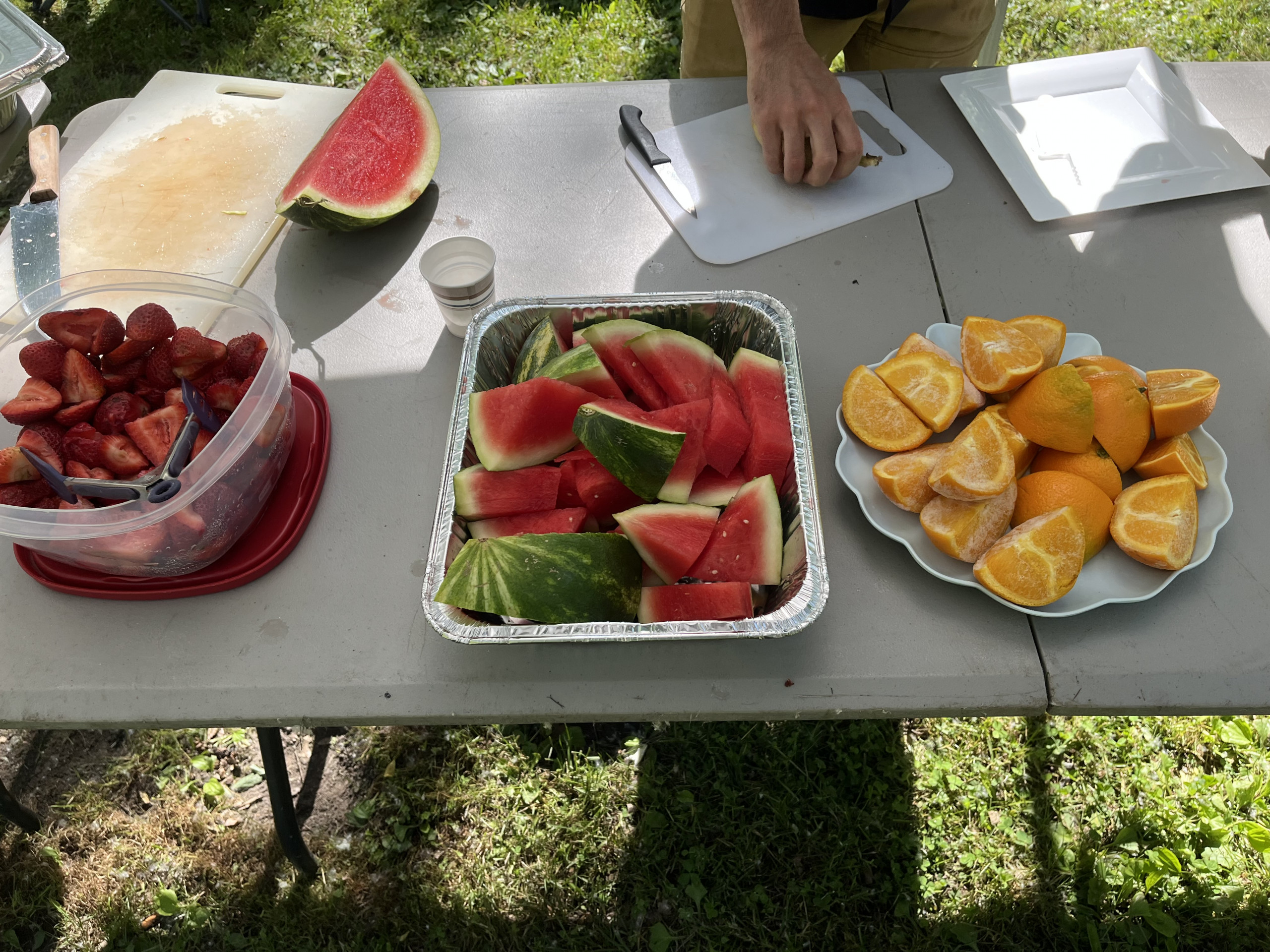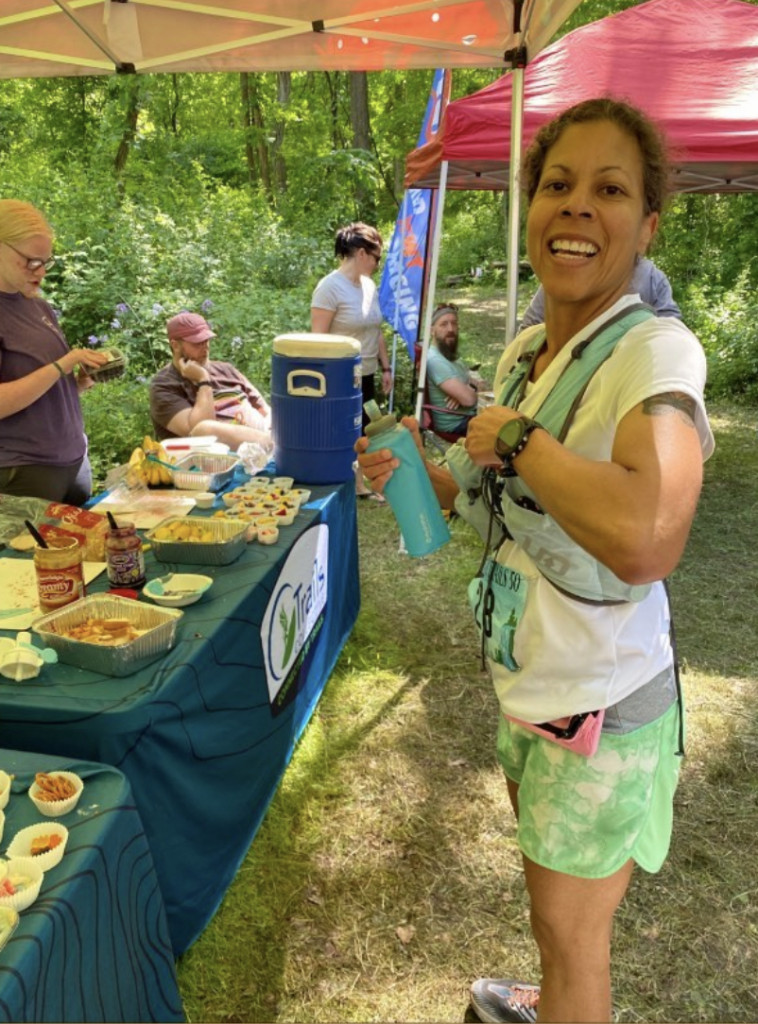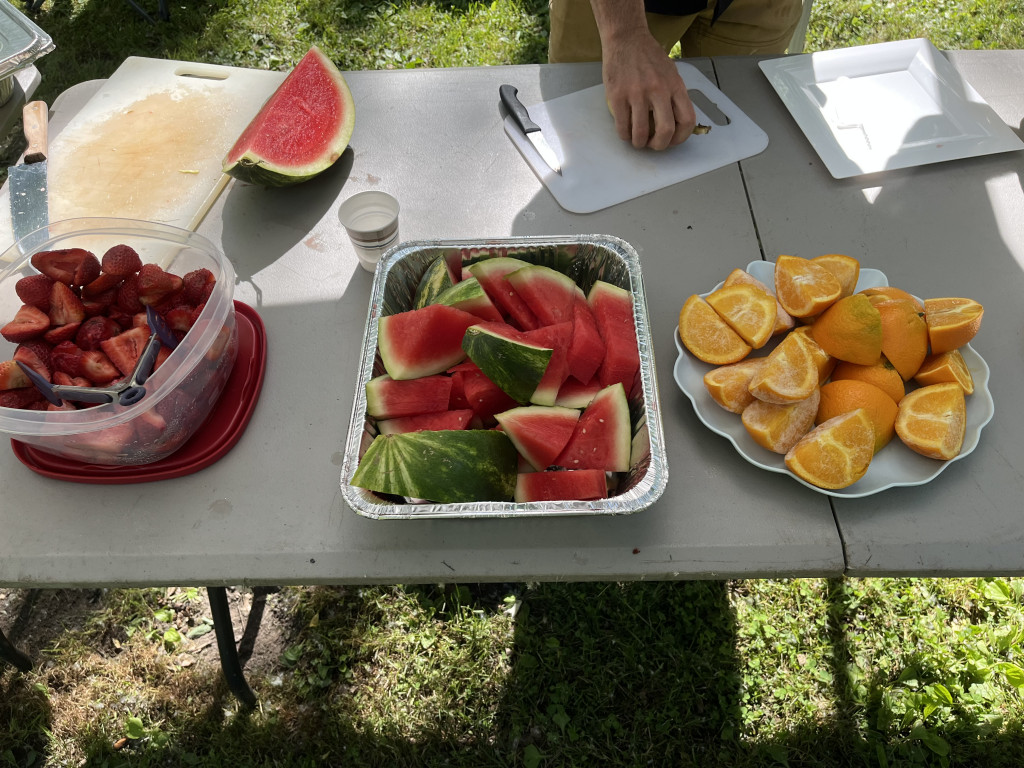Managing Aid Stations with Food Adversions
Racing season is here, and for many of us, that means we have at least one ultramarathon or trail race on the schedule, most of which will include visits to aid stations along the way. This can mean making tough decisions about nutrition, balancing how much you carry in with what you can find at aid stations, while minimizing your risk of exposure. For runners with certain autoimmune conditions, food allergies, or aversions, the risk of derailing ourselves in a race by eating something that makes us sick is very real.
May is Celiac Awareness Month, and my hope in writing this article is to help runners with certain autoimmune conditions, food allergies, or aversions safely navigate the aid stations they come across in races. The article will focus primarily on gluten, though I touch on some of the other food allergens. But before I dive in, I’d like to share a little of my own history. I’ll then explain the difference between “gluten-free” and certified “gluten-free”, while also defining allergies, sensitivities, and autoimmune disorders. I’ll end by making recommendations for foods at aid stations by need, as well as providing resources of Celiac runners.
My History
I have been gluten-free since 2018, though looking back, I believe my inability to tolerate gluten began not long after the birth of my second child. I knew it would take months for my belly to return to “normal” after birthing my babies, but after a year following this second birth, I found that it had not… I still looked pregnant most days. This is amazing when you actually are pregnant, when I found I could not wait for that belly to appear! But it can be devastating when you’re not pregnant…like the time that kind lady at Target asks you when your baby is due. Ouch.
For those not born with these intolerances, some suggest that these physical changes may be attributed to stress, and if this is the case, the timing of the onset of my gluten sensitivity coincided with my father’s death and birth of my second child in 2011. By August 2018 it had progressed to where I was planning every excursion around bathroom availability, as multiple visits to the loo were a normal part of every day. I was bloated and miserable, and ready to see a doctor…until an elimination diet identified the problem. The good news? I finally knew what the cause was and could address it and start to feel better. The bad news? My husband had just started making an amazing artisan bread and The Beer Tree had recently opened near me. You can’t put a price on feeling good, but I’ll admit that the loss of artisan bread and Beer Tree beer had me pretty devastated for a hot minute!
In the summer of 2018, when I was at my worst, I was healing from a pelvic fracture, likely the result of my previously undiagnosed osteopenia, another symptom of Celiac disease. I was also finishing my PhD dissertation. Talk about stress!
Regarding dairy, my body lost its ability to break down milk products back in 2006. If also stress related, then I blame finishing graduate school, beginning my first career, planning a wedding, and buying a house in a span of just two years. But that’s just life sometimes. I think I’ve missed Brie cheese the most.
So for the past three years, I had been following a dedicated “gluten free” diet. Unless it was a fresh fruit, fresh vegetable, or meat, it had to be labeled “gluten-free”, or I wouldn’t eat it. And that belly distension was gone…seemingly overnight. For once, I did not look pregnant.
However, just this past January, I began to struggle with intense fatigue and amenorrhea, the latter which I had not yet experienced before. Given my training in December, and leading into January, I initially attributed this to overtraining. I backed off the training significantly, and within days the amenorrhea ceased. My energy levels returned…a little. However, a month later I found that I was still tired all the time. I found it increasingly difficult to get out of bed in the morning, and as a morning person this confused me (and annoyed my husband). If I had an alcoholic beverage with dinner, I would wake up in the middle of the night, my heart racing, and then suffer insomnia for several hours. The fatigue was relentless, and that familiar glutened feeling of wanting to stop mid-run to lie down in the road had returned with a vengeance. I was also feeling a tremendous brain fog, unable to think straight, and I was painfully unmotivated to do anything but run and sleep, though I started dreading the fatigued runs. And I was terribly depressed. I was clearly not myself.
Recognizing the symptoms, I decided to explore Celiac disease further, and understand the difference between foods labeled “gluten free” and those that were “certified gluten free.” On a Friday I began eating only fresh produce, unseasoned meats, and foods labeled “certified gluten free.” Within days, the fatigue lifted, the brain fog began to dissipate, and my energy levels rebounded to a point that felt greater than before this onset. And within DAYS, I was no longer depressed. I now know they call this “gluten fog” and “gluten-depression.” I never imaged there could be such a thing, how a food substance (other than alcohol) could affect your brain this way.
I was suddenly terrified, as I quickly scrambled to readjust my go-to foods and replace those now deemed unsafe with those that were clearly safe. And my husband, who does most of our cooking, received an education on true GLUTEN-FREE cooking that he had not previously anticipated. Now when he’s making pizza, for example, I leave the kitchen with any food I am preparing. My oat flour is stored separately. And my food is only seasoned with salt or real onions and garlic. As it turns out, “gluten-free” is not the same as “certified gluten-free,” and this becomes critical for those suffering from Celiac disease and other autoimmune disorders.
So what is the difference between “gluten-free” and “certified gluten-free”?
For a food to be certified gluten-free, it must be tested by one of three outside companies, and found to contain < 20 ppm gluten. It should be noted that 20 ppm is still much too high for those with Celiac disease and certainly allergies. The Gluten-Free Certification Organization (GFCO) tests and certifies foods containing < 10 ppm gluten. Foods that are labeled gluten-free are supposed to be tested in-house and found to contain < 20 ppm gluten. However, some foods on the market do not formally test their products, simply basing their labeling on the ingredients contained in the product. And as was explained to me recently by a friend at a major nutrition company, it also depends on what time of the day the product is tested in-house. One batch of “gluten-free” cereal may contain 12 ppm and you may not react to it…another batch you buy a month layer may contain 18 ppm and leave you wondering why you are suddenly unwell if the item says it is “gluten-free.”
Regarding oats…oats are naturally gluten-free but are often grown in fields adjacent to wheat fields and processed in the same facilities. Purity protocol oats are grown in a dedicated field and processed in a dedicated facility. “Gluten-free” oats that are not purity protocol undergo a sorting process and are then deemed “safe.” Fingers crossed, of course, that the sorting was adequate.
And to complicate matters further, some companies make mistakes when packaging their products or test products during the wrong time of the day. Mistakes happen, but when they do, they can leave some of us feeling unwell for days. However, for people with allergies, it can potentially be life-threatening.
Let’s define the differences:
- Wheat allergy: results when your body produces antibodies to proteins found in wheat (albumin, globulin, gliadin and gluten), in response to exposure. May result in anaphylaxis and be life threatening. (Mayo Clinic)
- Celiac disease: an immune response triggered in your small intestine in response to consuming gluten, a protein found in wheat, but also barley and rye. (Mayo Clinic)
- Non-celiac gluten/wheat sensitivity: may result in symptoms similar to those of Celiac disease.” (Celiac Disease Foundation) This is the diagnosis is assigned to those who exhibit symptoms of Celiac disease, but who test negative for the disease. Testing includes a blood test for antibodies (only present when you’re still eating gluten), genetic testing, or an upper endoscopy to conduct a biopsy of the upper intestine. The latter is commonly the most conclusive of the tests. It should be noted that many Celiacs initially test negative for the disease.
According to the Mayo Clinic, over time, the Celiac immune response damages your small intestine’s lining and results in malabsorption of nutrients. Individuals experience symptoms such as diarrhea, fatigue, weight loss, bloating, and anemia. Celiacs with negative blood tests eventually test positive for the disease from the upper endoscopy procedure.
I believe my own gluten sensitivity may be progressing to Celiac disease, based on my symptoms. However, I’m not sure I would get a positive blood test because I don’t consume enough gluten to produce the antibodies measured by the test. Nevertheless, I now eat as someone formally diagnosed with Celiac disease would, as eating any other way leaves me ill.
So what does all this mean for racing season?
Ultramarathons and Food Intolerances
Whenever I travel, I carry most of my own nutrition with me. This also applies as I travel on my feet during long runs and ultramarathons. Aid stations are amazing and the volunteers ready to assist with any of your needs are even more amazing. What is not amazing, however, is the spread of food options as they often appear to the Celiac ultrarunner. Subtleties…like the sandwiches and cookies right next to the orange wedges and watermelon slices. On his blog, mountain runner Gabe Joyes shares his experience watching a volunteer handle sandwiches, prior to handling another runner’s ice cubes. While these details may be negligible to most runners, the resulting cross contamination can spell disaster for the Celiac athlete.
If you have food allergies or sensitivities, you are likely accustomed to reading labels and scrutinizing new foods, prior to consuming them. Those with severe food allergies should carry an Epi-pen along with them in their hydration vest. Severe food allergies often result in anaphylaxis with exposure to the allergen(s), and this can be potentially deadly to the affected runner racing without an Epi-pen. The safest option, of course, is to carry all your own nutrition and snacks on you, or for longer events, also stashing extras in drop bags along the way, to lessen your risk of exposure. If you do plan to rely on aid station menus, consider researching what brands of candies, chips, pretzels, cookies, peanut butters, jams, meats, breads, etc. are safe for you. You may be able to ask aid station volunteers what brand of cookies are there, and they may or may not know. But what you don’t want is to be trying to read a list of ingredients on the potato chips bag in the middle of a race if you are trying to minimize your time at aid stations.
Below, I offer some recommendations, based on my own experiences and on those of several family members. These are only suggestions, and you’ll need to do the research in advance of the race, to be sure these foods will work for YOU. I cannot emphasize this enough.
Also, be aware of foods that are free of some allergens but may potentially be cross contaminated from the production factory. These foods should be labelled accordingly on the packaging, somewhere below the ingredient list. Make sure you look for this.
Aid station recommendations:
- DAIRY SAFE: boiled potatoes, most pretzels, bacon, pickles, plain salted potato chips (many BBQ chips contain milk and are UNSAFE), most tortilla chips, jams, peanut butter, some breads, gummi bears, Sour Patch Kids, Oreos, anything labeled VEGAN*
- GLUTEN SAFE: boiled potatoes, some bacon, fresh fruit, most pickles, most cheese, most potato chips, most tortilla chips, Sour Patch Kids (depending on your level of sensitivity)
- EGG SAFE: boiled potatoes, most pretzels, bacon, pickles, most grilled cheese, most breads, jams, cheese, Oreos, anything with a bag labeled VEGAN*
- NUT SAFE: boiled potatoes, most pretzels, bacon, pickles, most grilled cheese, breads, jams, cheese, Oreos
- SOY SAFE: boiled potatoes, some pretzels, some bacon, pickles, some bread, most cheese, some grilled cheese (tough because many foods contain soy byproducts, such as soy lecithin)
* VEGAN means free of any animal products (eggs, dairy, meats); however, there is still a potential for cross contamination, unless specified otherwise.
Prepared foods at aid stations, such as lasagna, tomato soup, soup broth, burritos, and quesadillas, are best avoided, unless you have no food aversions and you’ve trained with these. In gels and electrolyte drinks, watch for ingredients such as maltodextrin or caramel coloring, which may be sourced from a gluten grain. Note that colas and other dark sodas contain caramel coloring, which is a potential source of gluten. Smoke flavoring may also be sourced from gluten.
Recently, I reached out to Gabe Joyes, who was gracious enough to share his recommendations on fueling with Celiac disease with me. Gabe was diagnosed with Celiac disease in 2012 and does not eat anything at an aid station unless he knows it to be 100% safe, otherwise it could “end his race in a hurry.” Gabe fuels with Skratch Labs, Spring Energy, and gluten-free Honey Stinger waffles.
Olympic marathoner Stephanie Bruce is co-founder of Picky Bars and was diagnosed with Celiac disease in 2010. She also has a dairy and egg allergy. Stephanie fuels using Gatorade and may follow a workout with smoothies or Picky Bars.
Olympic track runner Amy Yoder Begley was initially misdiagnosed as having a dairy intolerance, but a blood test revealed she suffered from Celiac disease. By the time of her diagnosis, she also suffered from osteopenia, nutritional deficiencies, and hypothyroidism. For years she couldn’t get through a workout without having to use the bathroom and was plagued with GI distress. However, her recovery was profound, and two years later she qualified for the 2008 Olympics.
As for me, my own preferred way to fuel is with Tailwind Nutrition. Their products provide the energy I need for long efforts and are safe for me. My favorite flavors are mandarin orange (Endurance Fuel) and vanilla (Recovery). In addition to Tailwind, I also enjoy MacroBars, Honey Stinger chews, Picky Bars, and Once Again Peanut Butter (amazing with bananas, ice cream, or by the spoonful!) And post-run oat flour pancakes with Earth Balance margarine and New York maple syrup are the bomb.
Having a food intolerance, autoimmune condition, or food allergy may complicate fueling at aid stations mid-race, but it is possible to navigate these challenges and fuel yourself, while still running well. For those of us dealing with food aversions in a race, knowledge becomes power.
Add Comment
You must be logged in to post a comment.










